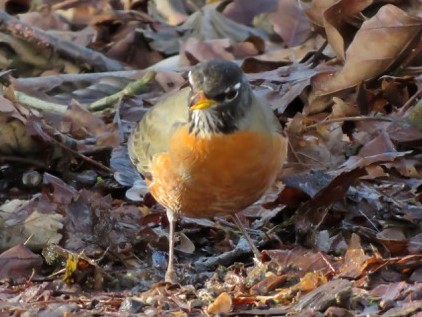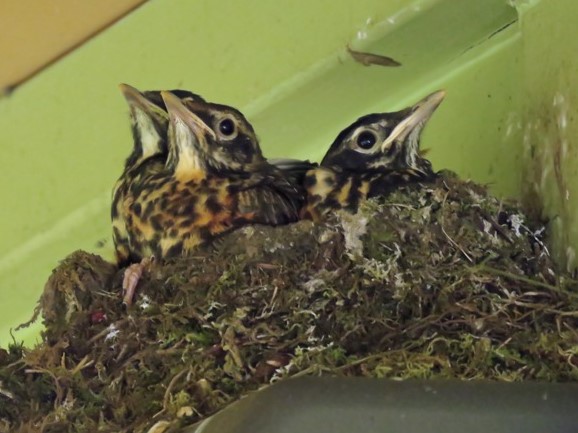 |
| Note the distinctive black and white striped throat. Both males and females have that look. Females are generally lighter in coloring all over |
By Christine Southwick
All photos by Elaine Chuang
The Robin’s early morning wake-up song really does sound like “Cheer up” “get out of bed.”
The American Robin is so well known that a saying was created after seeing them in parks, fields and yards; “The early bird gets the worm.” Robins are a familiar sight running across lawns tilting their heads hunting for worms. Recent research has proven that they hunt by sight, not sound.
 |
| Robins routinely eat fruit -- many fruit growers have to put up nets to prevent birds from eating the fruits. |
The American Robin is so familiar that its size is used by birders as a size-guide; “Is it larger or smaller than a robin?” Even a color has been named after robins — Robin’s-egg blue.
The name “American Robin” was given to local birds in 1703 by homesick English colonists who were reminded of a red-breasted bird from England. The American Robin belongs to the Thrush Family — the bird that it was named after belongs to the Flycatcher Family.
 |
| American Robin fledgling -- barely out of the nest -- both parents will feed it for several weeks at least until after it can fly |
Robins eat worms, grasshoppers, bugs, fruits and berries. They will not fly up to a seed feeder, though they will use a fly-through feeder containing fruit.
They build their nests in trees, eaves or ledges. They will not use a birdhouse but will use an open-shelf-design positioned where a crow can’t get to it.
 |
| An ideal nesting site - up under an eave which is too cramped for crows to swoop in and nab a nestling |
They are seasonally monogamous. The female builds the nest and has 3-6 bluish eggs, and both help with the feeding. The juveniles start out with a spotted breast for camouflage which changes to the red breast during the summer.
American Robins form flocks in late fall / early spring and migrate latitude-ally, meaning that the robins you see breeding here in the summer usually fly further South in the winter, and the robins you see in the winter probably nested in Canada, and reverse their locations in the spring.
Robins really are a striking bird with their distinctive white / black striped throats, incomplete white eye-ring, distinctive red breast, and large size. Take time to really look at the next ones you see.
And like the song say, “Live, love, laugh and be happy…”

No kidding they like fruit! Every year I have one or two that park themselves in the blueberry bush and don't leave until it's stripped bare :)
ReplyDelete